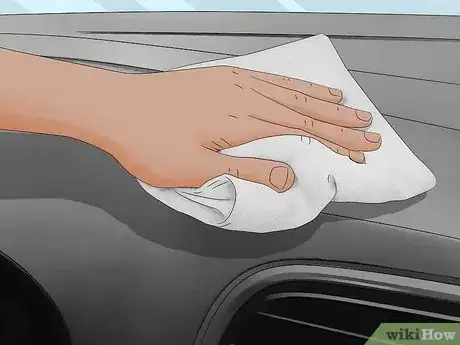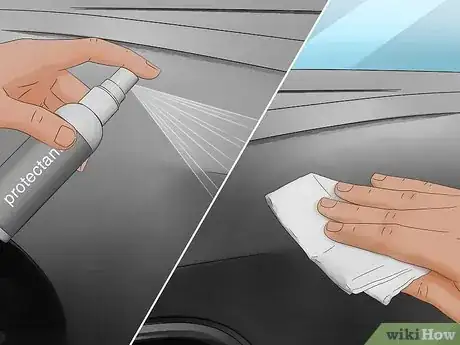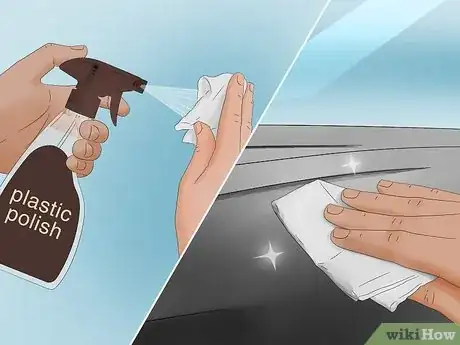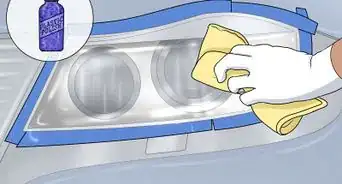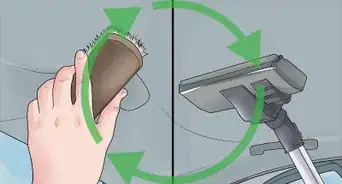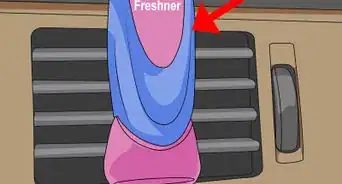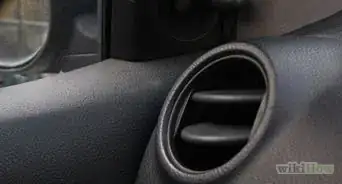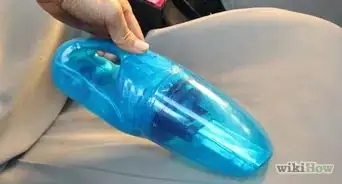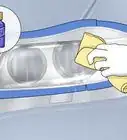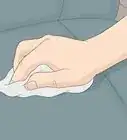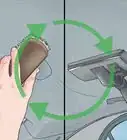This article was co-authored by Chad Zani. Chad Zani is the Director of Franchising at Detail Garage, an automotive detailing company with locations around the U.S. and Sweden. Chad is based in the Los Angeles, California area and uses his passion for auto detailing to teach others how to do so as he grows his company nationwide.
There are 12 references cited in this article, which can be found at the bottom of the page.
This article has been viewed 307,813 times.
Practicing good car maintenance both inside and out will help your vehicle both hold resale value and be a source of pride for you. Your car has both interior and exterior plastic. To clean the interior plastic, start by vacuuming and then using a soft cloth and a plastic safe cleaner. When cleaning your exterior plastic, wash your car first and then apply a degreaser. Always finish your cleaning sessions with some sort of protectant.
Steps
Cleaning Interior Plastic
-
1Vacuum the interior. Before you begin, vacuum out your car to remove any debris.Your cleaning products will work much better if you vacuum before getting started. Using a soft brush attachment on the vacuum nozzle will help prevent scratching. [1]
- Remove the floor mats and shake them before you start vacuuming.
- Be extra careful around any knobs or vents. These areas can be easily damaged.
-
2Dust the plastic. Use a soft damp cloth (water only) or soft hand-held dust mop (available in the car care section of any grocery or discount store) to clear away dust. A small, soft-bristled paintbrush works well to clear dust from crevices such as around the gear shift and hand brake, the radio controls and other tight spaces where dust can settle.[2]
- You can also use a soft-bristled toothbrush and Q-tips to clean crevices and hard to reach areas.
- If you used a damp cloth, go back with a dry soft cloth to dry the plastic.
Advertisement -
3Treat stains. If your plastic is stained, apply a very small amount of mild soap, laundry detergent, or plastic auto cleaner to a damp cloth. Never apply any cleaning solution directly to the plastic. Wipe the area until it is clean. Follow up with a clean, dry rag.[3]
- Always test an inconspicuous piece of plastic before you apply it to all of the plastic in your car.
- If you are using a commercial plastic cleaner, follow the instructions on the packaging.
- Turn the cloth to a clean spot when it begins to show dirt. You do not want to redistribute dirt throughout your car.
-
4Apply a protectant. Once your plastic is cleaned, apply a protectant. Visit an automotive store or the automobile section of a large retailer to find a plastic protectant. Only apply the protectant to clean surfaces. You do not want to lock in any dirt or grime.[4]
- Again never spray products directly on the plastic. Always use a clean, soft cloth or a foam applicator pad.
-
5Use polish. To add some shine to your plastic, use a plastic polish or an oil such as olive oil or boiled linseed oil. Put some oil or polish on a soft cloth and then rub it into the plastic. Then use a clean soft cloth to rub away any excess product.[5]
- You can purchase boiled linseed oil from a hardware or paint store.
- There are also all-in-one products that act as both a polish and a protectant. This is convenient and cuts down on the amount of products you have to buy.[6]
Taking Care of Exterior Plastic
-
1Wash your car. Pre-soak your car with water for 5 minutes to remove any stubborn dirt. Place a few drops of a mild liquid soap (e.g. Ivory soap) in a bucket of water and use a sponge or car wash mitt to clean your car. Wash your car in sections and rinse with plain water. Start at the top of your car and work your way down. Once you have cleaned your entire car, rinse the car with water again.
- Clean your car in a shaded area to prevent your car from getting too hot. If the surface of the car is too warm, the soap may dry and you will have to wash your car multiple times.
- Dry your car with a clean, soft, dry towel or drive your car around the block.
-
2Apply a degreaser. Once you have washed the car, spray a light degreaser on a towel and apply it to the plastic areas of your car. Wipe your car using a medium amount of pressure. If the area has buildup, scrub with a brush. Be careful not to scrub the paint.[7]
- Purchase a light degreaser that is safe for cars. Visit your local automotive store or the automotive section of a large retailer like Walmart or Target.
- The degreaser will also remove any buildup from other products that you applied.
-
3Restore dull plastic. Many cars these days have black plastic trim. This trim can begin to look dull and worn. A restoring product will provide a deep clean and restore some of the color. Apply a couple of nickel sized drops of the solution on a soft towel and rub it into the plastic areas using medium pressure.[8]
- These products will remove stains and improve the color.
- Some good products you can try include Poorboy’s Trim Restorer, TUF SHINE Black Restore Kit, or Black WOW, or Mother’s Back-to-Black cream.[9]
- Always read the instructions before using the product on your car.
-
4Apply a protectant. A good protectant will protect the exterior plastic from UV rays and keep the trim looking like new. Spray the protectant on a clean, soft towel and wipe it on your car using a back and forth motion. The protectant should only take a few minutes to dry.[10]
- These protectants can often be used on multiple surfaces such as plastic, vinyl, and rubber.
- Always degrease the surface before applying the protectant.
Maintaining a Clean Car
-
1Clean your car regularly. Clean the interior of your car once a month, and the exterior of your car twice a month. If you have a regular cleaning schedule, your cleaning sessions will not take as long. If you cannot clean your car this often. At least try to clean your car at regular intervals.[11]
- You may need to clean your car more often if you live near the coast, have salted roads in the winter, or live in a wooded area with tree sap.
- Remove and shake out your car mats once a week as well.
- To clean car carpet, attach a carpet brush to the end of a cordless drill. Clean the surface with a special stain remover or foaming wash—the drill does most of the work for you. You can also use specialized brushes for upholstery and rubber, if needed.[12]
-
2Remove trash daily. Your car is not a trash bag. Remove empty cups, plastic wrappers, or any other trash every day. It may help to keep plastic bags in your car for trash collection. You can then throw the bag away at the end of the day.[13]
-
3Read the owner’s manual. Before you do any interior cleaning, read your owner’s manual. Your car materials may be sensitive to certain cleaners or your manufacturer may recommend specific cleaning products. Always test products in an inconspicuous spot before you apply it to all of the interior.[14]
- The owner’s manual may also have cleaning tips for your car. If you do not have a hard copy of the manual, you can often find the manual on the manufacturer’s website.
Community Q&A
-
QuestionHow do I remove dried-on mud from a plastic interior when Armor-All didn't work?
 Community AnswerYour best bet is to use a dish brush with a 3:1 mixture of mild dish soap and water. Don't use a brush that's too harsh, as you may scratch the plastic.
Community AnswerYour best bet is to use a dish brush with a 3:1 mixture of mild dish soap and water. Don't use a brush that's too harsh, as you may scratch the plastic. -
QuestionThe car mileage meter is covered by transparent plastic. I used dashboard cleaning liquid to clean the plastic, but now it is stuck on the cover. It is difficult for me to see my meter now. What should I do?
 Community AnswerApply a degreaser to the plastic to remove any of the buildup of product. Follow up with a plastic safe cleaner.
Community AnswerApply a degreaser to the plastic to remove any of the buildup of product. Follow up with a plastic safe cleaner. -
QuestionHow to fix scratched plastic?
 Community AnswerClean the area and then apply some sort of plastic solvent, adhesive, or filler. Once it dries, sand the area, and then use plastic paint. You can purchase a plastic scratch kit from an automotive store. All of the products that you need will be included. Always read the instructions before you use any product.
Community AnswerClean the area and then apply some sort of plastic solvent, adhesive, or filler. Once it dries, sand the area, and then use plastic paint. You can purchase a plastic scratch kit from an automotive store. All of the products that you need will be included. Always read the instructions before you use any product.
References
- ↑ http://www.samarins.com/maintenance/interior.html
- ↑ http://www.samarins.com/maintenance/interior2.html
- ↑ http://www.popularmechanics.com/cars/how-to/a5928/how-to-clean-your-car-interior/
- ↑ http://www.samarins.com/maintenance/interior2.html
- ↑ http://mommyfootprint.com/tag/diy-dashboard-polish-with-olive-oil/
- ↑ https://www.carthrottle.com/post/4-ways-to-restore-faded-black-plastic-trim/
- ↑ http://www.detailedimage.com/Auto-Detailing-Guide/Exterior-Trim-Care/
- ↑ http://www.popularmechanics.com/cars/how-to/a4383/4324365/
- ↑ http://www.detailedimage.com/Auto-Detailing-Guide/Exterior-Trim-Care/
- ↑ http://www.detailedimage.com/Auto-Detailing-Guide/Exterior-Trim-Care/
- ↑ http://www.meineke.com/blog/how-often-should-you-wash-your-car/
- ↑ Chad Zani. Auto Detailing Expert. Expert Interview. 2 October 2019.
- ↑ http://www.housecleaningcentral.com/en/cleaning-tips/tip/car-cleaning-tip.html
- ↑ http://www.cartalk.com/sites/default/files/features/detailing/images/tips.pdf
About This Article
To clean your car’s interior plastic, you can use a vacuum and some plastic-safe cleaner. First, remove any debris, and take the floor mats out and shake them off. When you’re ready to vacuum, use a soft brush attachment on the nozzle to prevent scratching your interior. After vacuuming the interior, dust the plastic with a soft damp cloth or a soft hand-held dust mop. For stains, apply a small amount of mild soap, laundry detergent, or plastic auto cleaner to the cloth. Once you’ve cleaned the plastic, apply a protectant to cleaned surfaces. To learn how to take care of your car’s exterior plastic, keep reading!

